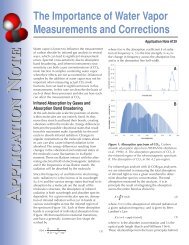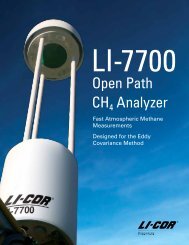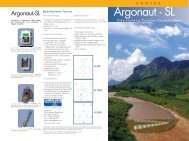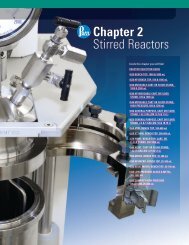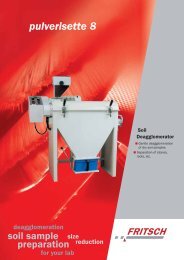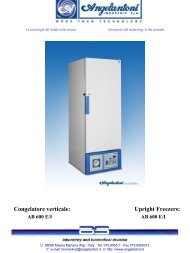Solar Power for Eddy Covariance Stations
Solar Power for Eddy Covariance Stations
Solar Power for Eddy Covariance Stations
You also want an ePaper? Increase the reach of your titles
YUMPU automatically turns print PDFs into web optimized ePapers that Google loves.
<strong>Solar</strong> <strong>Power</strong> <strong>for</strong> <strong>Eddy</strong><strong>Covariance</strong> Flux <strong>Stations</strong>Technical NOTELI-COR greenhouse gas analyzers, includingthe LI‐7200/LI-7500A CO 2/H 2O Analyzers,the LI-7700 Open Path CH 4Analyzer, andgreenhouse gas analyzer systems, are designedto monitor fluxes of CO 2, H 2O, andCH 4from natural and human-managed environments.Frequently, these instruments aredeployed in remote locations without accessto grid power. Off-grid power sources mustbe used at these sites.In recent years, photovoltaics (solar cells thatconvert sunlight to electricity) have becomeincreasingly popular as energy sourceswhich can be used in most remote locations.Off-grid photovoltaic (PV) power systems(Figure 1) consist of solar panels, batteries,electronics, enclosures, and a supportingstructure. Constructing an efficient PV powersystem requires careful planning throughoutthe process, from selecting components, toplacing the solar array. In this technical note,we describe some important considerationsand provide guidelines <strong>for</strong> constructing anoff-grid PV power source <strong>for</strong> eddy covarianceflux systems.Key PV system elements include:• <strong>Solar</strong> panels - convert sunlight into electricenergy• Deep cycle batteries - store power producedby solar panels and provide powerto instruments• Charge controllers - protect batteriesfrom overcharging and optimize the batterycharging function• Wires and cables - connect the electricalcomponentsSupporting structures include:• Panel mounting - supporting framework<strong>for</strong> the solar panels• Battery enclosure - protects batteries andcharging circuitry from environmentalelements1Figure 1. A solar power system used to power aneddy covariance flux system.Optional system components include:• Combiner box - combines the outputof each individual solar panel into onecircuit• Disconnects - circuit breakers that protectthe various system components; onedisconnect is placed between the solarpanels and the batteries and another isplaced between the batteries and theinstrumentsDesigning a PV systemThe main challenge <strong>for</strong> the off-grid PVsystem is to ensure that it can keep up withregular power demands and can provideenough power during infrequent peak periods.Keys to the design of such a system are:(1) computing power demands of the instruments,(2) evaluating how many batteries areneeded to ensure operation at night and onovercast days, and (3) determining the numberof solar panels that are required to satisfypower demands.<strong>Power</strong> RequirementsThe first important item to consider be<strong>for</strong>edesigning a PV system is the power requirementsof your system. Table 1 providespower requirements <strong>for</strong> some commoninstruments used in CO 2/H 2O flux measure-
ments. Table 2 shows the power requirements <strong>for</strong>the LI-7700 Open Path CH 4Analyzer in a variety ofconfigurations. Although Tables 1 and 2 give powerrequirements <strong>for</strong> normal operation, warm-up periods,and with accessories, the most important valuesto consider are the average daily wattage, which isdetermined based on the settings of each particularinstrument.Table 1. <strong>Power</strong> requirements <strong>for</strong> instruments commonlyused in flux stations. Maximum power consumption <strong>for</strong> theLI-7200 and LI-7500A occurs during the warm-up period,which typically lasts about 10 minutes after the instrumentsare powered up.InstrumentLI-7200 EnclosedCO 2/H 2O Analyzer7200-101 FlowModuleLI-7500A Open PathCO 2/H 2O AnalyzerWindMaster SonicAnemometerNominal <strong>Power</strong>Consumption (W)Warm-up <strong>Power</strong>Consumption (W)30Determining the parameters of yoursystemAppendix A is a step-by-step guide <strong>for</strong> calculatingvarious parameters of a PV system used to powereddy covariance flux systems. In the following sections,we follow the step-by-step instructions presentedin Appendix A using the column called “Example”.Appendix A also includes a column called“Your System”, which you can use to compute theparameters <strong>for</strong> your solar power system.1215121Table 2. <strong>Power</strong> requirements <strong>for</strong> the LI-7700 Open Path CH 4Analyzer andaccessories. The cleaning cycle duration is from 10 to 120 seconds (30seconds typically). Mirror heater power consumption is user-settable from 0to 7.5 watts. *It is only necessary to include LI-7550 power requirements ifthe LI-7550 is used solely with an LI-7700. Do not include the LI-7550 powerrequirements if it is part of an LI‐7500A or LI-7200 CO 2/H 2O Analyzer.CH 4 AnalyzerWasher AssemblyUpper Mirror HeaterLower Mirror HeaterWith LI-7550*TotalNormalOperation(W)8 8- -- -- -- 108 18DuringCleaningCycle (W)8 88 8- -- -- 1016 26n/a301Mirror Heaters On (W)Compute the flux system wattageTo compute the power demands of your system,begin with step 1 in Appendix A. List all the devicesthat will be powered by your solar system and computethe total wattage that the system must provide.It is important to note that the in<strong>for</strong>mation requiredin these steps is experiment-specific and will dependon the type of system you construct. The exampleassumes a system composed of the LI-7700, theLI-7500A (which includes the LI-7550), a Gill Wind-Master sonic anemometer, and an Internet radio.Compute amp-hours per dayTo compute amp-hours per day, multiply the totalsystem wattage (from step 1) by 24 hours/day. Computestep 4 by adding the loss factor (we assumed aconservative 20% battery loss) to the value of step 2(e.g., multiply step 2 by 1.2). Calculate the total amphoursper day by dividing the results of step 4 by thegiven system voltage in step 5. Enter the result in step6. This number (amp-hours per day) is important <strong>for</strong>both battery bank and solar panel calculations.Determine the size of the battery bankBatteries are needed to provide power to the systemduring the night and through periods with overcastskies. The size of the bank will varywith latitude and increase with thenumber of days the system needs torun without solar panel input. The examplein Appendix A, step 7 is 4 days.First, determine the acceptable numberof days that can pass without solarinput based on study site location andpersonal preference. The value enteredin Appendix A, step 7 will equal themaximum allowable number of daysyou are willing to tolerate without sunpower. Entering 4 days here ensuresthat your system will continue to operatein the design envelope without exceeding thebattery discharge threshold (step 9), however, thesystem can and will continue to operate until thebatteries are completely discharged. Note that if thebatteries become excessively discharged, they maybe damaged.8 8 8 8- - - 80-7.5 0-7.5 0-7.5 0-7.5- 0-7.5 0-7.5 0-7.5- - 10 108-15.5 8-23 18-33 26-41To compute the number of deep-cycle batteries touse in your system, follow steps 7-16. Because batteriesshould never be fully discharged, these examplesconservatively assume that 50% is the maximumacceptable battery discharge (step 9). This numbermay be lower or higher depending on specific batteries.Again, this does not guarantee that batterydischarge will not exceed 50% in certain circumstances.2
PV system provides extremely high current and canmelt/burn equipment or people very rapidly.The solar system also must be properly grounded inorder to prevent bodily injury, damage to equipmentfrom faulty electrical components, and damage toequipment from lightning strikes. A Ground Fault CircuitInterrupter (GFCI) provides additional protectionby detecting an unintended current path to groundand breaking the circuit if this occurs.Installation by a professional electrician, particularlyone who specializes in PV systems, is the most reliablechoice, especially if there are specific regulationson the electrical setup and operation. However,with proper precautions, simple and reliable selfmadePV systems can be successfully designed andconstructed (Figure 5).It also is important account <strong>for</strong> battery weight andstudy site location, as carrying multiple lead-acidbatteries over long distances may be difficult.Wind resistanceStrong winds can apply considerable <strong>for</strong>ce to a solarpanel array. There<strong>for</strong>e, the frame, mounting structures,and anchors must be heavy enough and strongenough to resist the <strong>for</strong>ce of strong winds. A concretefoundation is the most secure mount but anchoringstakes or sandbags will also work. Place the stakes orsandbags near the corners of the frame <strong>for</strong> the bestanchoring.Additional in<strong>for</strong>mation on PV systemdesignEssential and optional components of the PV systemare listed in Table 3. Figure 4 is a wiring diagram ofa PV system that is similar to the system describedin the example in Appendix A. This is one possibleconfiguration, and components used in your systemmay differ from those shown in this schematic.Table 3. Essential and optional components of a PV system.EssentialOptional<strong>Solar</strong> panelsDC panelMounting structure Exterior disconnect <strong>for</strong> DCCables to batteries Bird deterrentDeep-cycle batteries Lightning rodVentilated battery boxBattery interconnect cableCharge controllerFusesEarth groundThere are numerous online and journal publicationson the subject, as well as manufacturer-providedmanuals <strong>for</strong> specific solar panels and commercial PVsystems. A few useful examples of such literature arelisted below.A brief review of PV system principles is providedonline by <strong>Solar</strong>4<strong>Power</strong> Advanced Energy Group at:http://www.solar4power.com/solar-power-basics.htmlSubsequent pages of this website also provide detaileddiscussions on the load, solar panel, andbattery bank calculations. Another excellent source<strong>for</strong> general in<strong>for</strong>mation on PV systems is the “SystemDesign” section of the Colorado <strong>Solar</strong> Electric Companywebsite:http://www.cosolar.com/system_design/systems_home.htmThis page explains the differences between on-gridand off-grid systems, AC and DC types of PV systemsand load estimates, and provides do-it-yourself instructionson assembling PV systems. A very detailed,step-by-step PV system worksheet calculator canbe found in the guide produced online by SunWizeTechnology Company: <strong>Solar</strong> System Design Guidesby SunWize:http://www.sunwize.com/catalog/solar-catalog.phpThis guide also contains look-up tables <strong>for</strong> the numberof solar hours <strong>for</strong> a given geographic region,and <strong>for</strong> weather-related corrections on system efficiency.A number of companies conduct PV systemassessment <strong>for</strong> specific cases free of charge with anequipment quote. Pricing will depend on the type ofsystem constructed, the geographic location of thesystem, and which optional accessories are purchased;expect to spend $3500-$5000 USD.Additional resourcesAmerican <strong>Solar</strong> Energy Society(http://www.ases.org)“A Consumer’s Guide: Get Your <strong>Power</strong> from the Sun”- The National Renewable Energy Laboratory, December2003(http://www.nrel.gov/docs/fy04osti/35297.pdf).“A Guide to Photovoltaic (PV) System Design andInstallation” – Endecon Engineering <strong>for</strong> Cali<strong>for</strong>niaEnergy Commission, June 2001 (http://www.energy.ca.gov/reports/2001-09-04_500-01-020.PDF)5
“Learning about PV: The Myths of <strong>Solar</strong> Electricity” -U.S. DOE Energy Efficiency and Renewable Energy,July 2008(http://www1.eere.energy.gov/solar/myths.html)National Center <strong>for</strong> Photovoltaics(http://www.nrel.gov/ncpv)BatteryTemp. SensorBattery VoltageSensorMaximum Point<strong>Power</strong> Tracking(MPPT) ControllerBattery(+)(-)Photovoltaic(+)GroundLightningArresterCommon<strong>for</strong> EarthGroundEarthGround<strong>Solar</strong> Panel Array+Common(-)-+-Load4 30 30 63 0.5BatteryShutoffPhotovoltaicShutoffGroundFaultCircuitInterupter+-(+) (-)Instruments15 15 15CombinerBoxTo any battery post+ - + -BATTERYBATTERYRecommended wire gauges. Be sureto select wire that is heavy enough <strong>for</strong>your system.Heavy Gauge Battery Cables8 Gauge Wire (minimum)10 Gauge Wire (minimum)18 Gauge WireFigure 5. Schematic of a solar power system. With three 125 watt solar panels, this system could provide power year aroundto an LI-7500A Open Path CO 2/H 2O Analyzer, LI-7700 Open Path CH 4Analyzer, Gill Windmaster Sonic Anemometer, and anInternet radio at LI-COR’s headquarters in Lincoln, NE (40.82°N, 96.68°W).6
Appendix A Determining the parameters of your system. This table can be used to compute various parameters<strong>for</strong> an off-grid solar power generator/storage system. Red numbers are user-defined variables; green numbers arerecommended values.Compute the flux system wattageStep1InstrumentsLI-7700LI-7500A (includes LI-7550)Sonic anemometer (Gill WindMaster)Internet radioTotalSource of In<strong>for</strong>mationInstrument specsInstrument specsInstrument specsInstrument specsInstrument specsInstrument specsInstrument specsUnitsWattsWattsWattsWattsWattsWattsWattsWattsExample8.012.01.06.027.0Your SystemCompute amp-hours per dayStep23456VariableAverage load (power per day)Battery loss factorCorrected <strong>for</strong> battery lossSystem voltageAmp-hours per day consumedSource of In<strong>for</strong>mationMultiply [1] by 24 (hours/day)Assumed conservativelyAdd loss factor [3] to [2]Instrument specsDivide [4] by [5]UnitsWatt-hours/dayPercentWatt-hours/dayVoltsAmp-hours/dayExample64820%77812.064.8Your SystemDetermine the size of the battery bankStep78910111213141516VariableNumber of dark days to supportAmp-hour storageDepth of discharge (100% istotal discharge)Total storage required,corrected <strong>for</strong> dischargeBattery ratingBattery voltageBatteries wired in parallelBatteries wired in series (<strong>for</strong>system voltage)Total # of batteries neededTotal # of batteries, roundedSource of In<strong>for</strong>mationSpecific to region/preferencesMultiply [6] and [7]50% is safe 80% usableDivide [8] by [9]Battery specificationsGivenDivide [10] by [11]Divide [5] by [12]Multiply [13] and [14]Round [15] upUnitsDaysAmp-hoursFractionAmp-hoursAmp-hoursVoltsNumberNumberNumberNumberExample4259.250%518.419062.725.46Your SystemDetermine the number of solar panelsStep1718192021222324VariableSun hours per day, worstmonthAmps required from solar panelsPeak amperage of solar panelEfficiency of charge controllerNumber of solar panels in parallelNumber of panels in series (12 V)Total number of solar panelsTotal number of solar panels,roundedSource of In<strong>for</strong>mationDepends on your region(Lincoln, NE; December)Divide [6] by [17]Panel specificationsMPPT ~97%divide [18] by ([19]*[20])Panels are nominally 12 VMultiply [21] and [22]Round [23] upUnitsHrs/dayAmpsAmpsPercentNumberNumberNumberNumberExample3.518.57.197%2.712.73Your System7
System output and charge controllerStep25262728Variable<strong>Power</strong> rating of the panelOutput of the off-grid systemVoltage of the solar arrayController amp ratingSource of In<strong>for</strong>mationPanel specificationsMultiply [24] and [25]<strong>Solar</strong> panel specsDivide [26] by [27]UnitsWattsWattsVoltsAmpsExample12537512.031.3Your SystemBattery charging timeStep29303132VariableTotal power generated by solarpanel per dayExcess power (to chargebatteries)<strong>Power</strong> to charge batteries to100% (including loss)Number of sunny days tocharge batteriesSource of In<strong>for</strong>mationMultiply [26] by [17]Subtract [2] from [29][11]*[15]*[5]*(1+[3])Divide [31] by [30]UnitsWatt-hrsWatt-hrsWatt-hrsDaysExample1312.5664.5820812.4Your System4647 Superior Street • P.O. Box 4425 • Lincoln, Nebraska 68504North America: 800-447-3576 • International: 402-467-3576 • FAX: 402-467-2819envsales@licor.com • envsupport@licor.com • www.licor.comIn Germany – LI-COR GmbH:+49 (0) 6172 17 17 771 • envsales-gmbh@licor.com • envsupport-gmbh@licor.comIn UK, Ireland, and Scandinavia – LI-COR Biosciences UK Ltd.:+44 (0) 1223 422102 1 • envsales-UK@licor.com • envsupport-UK@licor.comAll trademarks and registered trademarksare property of their respective owners.979-11336 07/10





